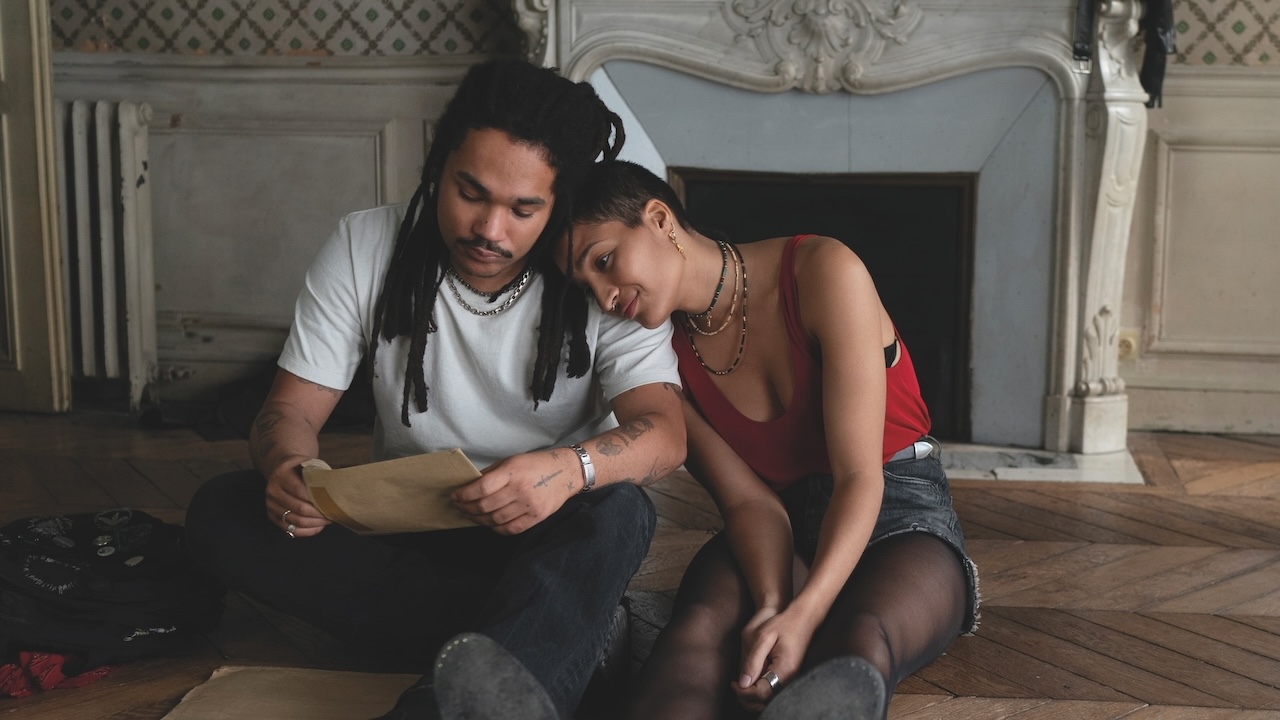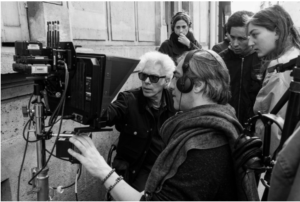FATHER MOTHER SISTER BROTHER
Νοέ 01, 2025 Κινηματογράφος 0

MOVIE REVIEWS
THREE FAMILY STORIES
Father mother sister brother: Giannis Fragoulis writes
We saw Jim Jarmusch’s film after the opening ceremony of the 66th Thessaloniki Film Festival. The latest film by the American underground filmmaker won the Golden Lion at the 82nd Venice Film Festival. Three different stories speak metaphorically about family. Underneath the text lies a profound reflection on family ties and the stories they entail.
Father mother sister brother: The movie
The father welcomes his children, a boy and a girl, after a long time. His son helps him to have a better life, but he has his own way of living, something he will keep secret. The mother is visited by her two daughters, they drink tea and eat delicious sweets, and when they leave they take their gifts with them. One of them hides aspects of her life, pretending to be a successful woman in her career and love life. Two brothers meet and go to the empty apartment of their parents, who were killed in a plane crash. Memories come back through objects and physical contact, showing us a close-knit family.
Jim Jarmusch makes his most personal film. This is what the artistic director of the Thessaloniki Film Festival, Orestis Andreadakis, said. I don’t know, and it’s difficult to confirm the accuracy of his statement. What I saw in this film is a reflection on family. Three different families are examined: the first is in the US, the second in Dublin, and the third between Paris and the US. So it has nothing to do with locality. The narrative opens up to the global arena. The father and mother are the first two elements we will examine. The two children follow.
Father mother sister brother: Father
The father is a marginal figure, far removed from the archetypal Father and, of course, from the strict father as defined by American tradition. His wife has died and he lives alone. He has never worked, so he has no income or social security, and his children help him, especially his son. He accepts this help in a discreet manner. However, his life is different from what he shows. He wants to live as he pleases, without giving anyone any rights. He keeps the way he enjoys his life a secret in conservative America.

Jarmusch shows us the conservative way of life that even middle-aged people still live, something that takes us back to the 1950s or 1960s, which the director himself has rejected. He suggests that we make room for enjoyment, which can also be erotic, and let people live as they wish, as long as they do not disturb others. He rejects the oppression of conservative children on their father and would like to see a family without prejudices and obstacles to human happiness. All this in a country where Trumpism triumphs is truly utopian.
Father mother sister brother: Mother
The mother lives in Dublin. Her daughters visit her very few times a year, even though they have moved to live near her. They will come to her house to drink tea and enjoy the delicious sweets she has bought. One daughter wants to hide her real life. The other is more “honest” and talks about her life without beating around the bush. The mother listens and comments very little. A clearly Victorian family where the mother claims her archetypal role.
In Paris, two siblings meet. Their parents have been killed in a plane crash. Their parents’ life transcends the compromises imposed by Western society. The children live their own lives and are quite close, to the point where you see an eroticism that is nothing more than the pleasure brought about by the genuine contact between two people. Their parents are absent, but their belongings, especially their photographs, serve as reminders. All the memories bring back a way of life that is unpretentious.

Father mother sister brother: The pleasure
The narratives in all three stories are very simple. There are no emotional or violent reactions. The twist appears in the first story when our father gives us a single clue about the lifestyle he has chosen. The viewer has a lot of narrative elements at their disposal, and it is not obvious that they will identify, following Brechtian logic, with the heroes of the film’s narrative. They must therefore find the points of reference they need to build the bridges necessary to enter the world proposed by Jim Jarmusch. As in his other films, such as Ghost Dog: The Way of the Samurai (1999), the director does not make it easy for the viewer to engage with his narrative. We must therefore work with him to create our own text, the metatext we will need to construct our own narrative.
I cannot know whether the director has included personal, experiential elements in the film’s narrative, but what I understood from watching his work is that he invites us to see things differently, from that proposed by the conservative Western view, the family as a whole and each individual separately, to discern the needs of each person that must be fulfilled, in a society that will demand respect from its members and will respect them in return.

Father mother sister brother: The power of simplicity
The violence that breaks down social bonds is absent here. Jarmusch proposes a different way of life; he does not impose it with his narrative, but rather gives us a clue to grasp and unravel the tangle, which is easy if we allow ourselves to enter the core of the narrative. So, once the viewer understands the structural elements of the narrative, they can make their own analyses, especially psychological ones, which will place them within their own value system. The film’s strength lies in its simplicity, its unadorned shots, its sparse dialogue, and its carefully crafted, visually appealing compositions.
The acting is excellent. Just enough to suggest without revealing too much. The looks and movements tell the story, creating small narrative structures that connect with each other to form a beautiful puzzle. The clear and simple dialogue, together with the other elements, places us in a realistic setting that is quickly challenged upon closer reading. The narrative gaps created by the dialogue and the actors’ movements are where the viewer’s imagination is produced and reproduced. Thus, the power of the film is multiplied, depending on how we attempt to read the cinematic text.
FATHER MOTHER SISTER BROTHER
Director: Jim Jarmusch
Screenplay: Jim Jarmusch
Cinematography: Frederick Elmes, Yorick Le Saux
Editing: Affonso Gonçalves
Music: Annika Henderson, Jim Jarmusch
Sound: Emmanuel Ughetto, Nicolas Cantin, Beso Kacharava, Avi Laniado
Set design: Judith Hynes, Jenny Oman, Lisa Scoppa
Costumes: Catherine George
Art direction: Paul Boulton, Frédéric Cambon, Fiona Cooney, Ramsey Scott
Production: Joshua Astrachan, Conor Barry, Richard Bolger, Arielle De Saint Phalle, Charles Gillibert, Carter Logan, Marieke Tricoire, Derrick Tseng, Atilla Salih Yücer
Cast: Tom Waits (father), Adam Driver (Jeff, son), Mayim Bialik (Emily, daughter), Charlotte Rampling (mother), Cate Blanchett (Timothea, daughter), Vicky Krieps (Lilith, daughter), Indya Moore (Sky, sister), Luka Sabbat (Billy, brother), Sarah Greene (Zanette), Philippe Azoury (dealer)
Year of production: 2025
Country of production: USA, Italy, France, Ireland, Germany
Language: english, french
Color: color
Genre: tragedy, comedy
Duration: 110 min.
More information about the components and technical specifications can be found here.
Read the reviews we have published
Σχετικά άρθρα
-
 THE GREAT LILIAN HALL
THE GREAT LILIAN HALLΙούν 09, 2025 0
-

-
 SCULPED SOULS
SCULPED SOULSΑπρ 29, 2025 0
-
 UNIVERSAL LANGUAGE
UNIVERSAL LANGUAGEΑπρ 27, 2025 0
Στην ίδια κατηγορία
-
 ΧΙΡΟΣΙΜΑ ΑΓΑΠΗ ΜΟΥ
ΧΙΡΟΣΙΜΑ ΑΓΑΠΗ ΜΟΥΔεκ 14, 2025 0
-
 ΑΝ ΕΙΧΑ ΠΟΔΙΑ ΘΑ ΣΕ...
ΑΝ ΕΙΧΑ ΠΟΔΙΑ ΘΑ ΣΕ...Δεκ 12, 2025 0
-
 Η ΦΩΝΗ ΤΗΣ ΧΙΝΤ...
Η ΦΩΝΗ ΤΗΣ ΧΙΝΤ...Δεκ 09, 2025 0
-
 ΣΤΟ ΝΗΣΙ ΤΟΥ ΆΜΡΟΥΜ
ΣΤΟ ΝΗΣΙ ΤΟΥ ΆΜΡΟΥΜΔεκ 05, 2025 0
Αναζήτηση
-
 WONDER WOMAN
WONDER WOMANΙούν 09, 2017 138
-
 ΠΑΙΔΙΚΗ ΣΚΗΝΗ
ΠΑΙΔΙΚΗ ΣΚΗΝΗΟκτ 12, 2014 2
-
 ΚΛΗΡΩΣΗ ΠΡΟΣΚΛΗΣΕΩΝ
ΚΛΗΡΩΣΗ ΠΡΟΣΚΛΗΣΕΩΝΜαρ 22, 2014 2
-
 ΔΥΟ ΜΕΡΕΣ, ΜΙΑ ΝΥΧΤΑ
ΔΥΟ ΜΕΡΕΣ, ΜΙΑ ΝΥΧΤΑΝοέ 13, 2014 2
-
 ΑΧΙΛΛΕΑΣ ΨΑΛΤΟΠΟΥΛΟΣ
ΑΧΙΛΛΕΑΣ ΨΑΛΤΟΠΟΥΛΟΣΝοέ 09, 2014 2
-
 ISTABUL FILM FESTIVAL
ISTABUL FILM FESTIVALΜαρ 08, 2014 2
-
 ΟΙΚΟΓΕΝΕΙΑΚΕΣ ΥΣΤΕΡΙΕΣ
ΟΙΚΟΓΕΝΕΙΑΚΕΣ ΥΣΤΕΡΙΕΣΔεκ 16, 2025 0
-

-
 ΧΙΡΟΣΙΜΑ ΑΓΑΠΗ ΜΟΥ
ΧΙΡΟΣΙΜΑ ΑΓΑΠΗ ΜΟΥΔεκ 14, 2025 0
-
 ΑΝ ΕΙΧΑ ΠΟΔΙΑ ΘΑ ΣΕ ΚΛΩΤΣΟΥΣΑ
ΑΝ ΕΙΧΑ ΠΟΔΙΑ ΘΑ ΣΕ ΚΛΩΤΣΟΥΣΑΔεκ 12, 2025 0
-
 Η ΦΩΝΗ ΤΗΣ ΧΙΝΤ ΡΑΤΖΑΜΠ
Η ΦΩΝΗ ΤΗΣ ΧΙΝΤ ΡΑΤΖΑΜΠΔεκ 09, 2025 0
-
 ΣΤΟ ΝΗΣΙ ΤΟΥ ΆΜΡΟΥΜ
ΣΤΟ ΝΗΣΙ ΤΟΥ ΆΜΡΟΥΜΔεκ 05, 2025 0

Δείτε το τρέιλερ της ταινίας μας, που συμμετέχει το Φεστιβάλ Ντοκιμαντέρ Θεσσαλονίκης.
SOTOS, EVERLASTING PAINTER (TRAILER)
Youtube
Επικοινωνήστε
ΓΙΑΝΝΗΣ ΦΡΑΓΚΟΥΛΗΣ
Email: info@filmandtheater.gr
Τηλ: (+30) 6974123481
Διεύθυνση: Ιωαννίνων 2, 56430, Σταυρούπολη Θεσσαλονίκη
![]()

